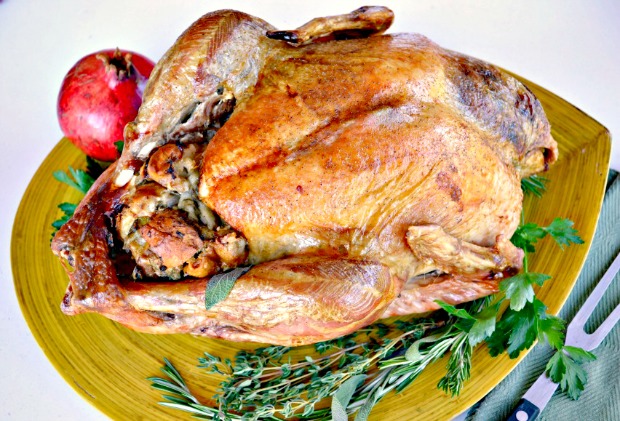Food
4 min Read
A Turkey Tutorial

April 11, 2014
Food
4 min Read

April 11, 2014


With Easter coming up next weekend, I thought it would be a good time for a little turkey roasting refresher. For most of us, cooking a big bird twice a year isn’t enough to remember cooking weights and times – and if it’s your first, it’s a good time to get to know the basics.
Here in Alberta, I like sourcing a bird that was raised with great consideration for its health and comfort, in our own big Alberta back yard, from our friends Darrel Winter and Corrine Dahm of Winter’s Turkeys.

They raise their flock about 30 km east of Calgary, on a small farm in the tiny Rocky View hamlet of Dalemead. It’s the family farm – the same one Darrel was born on – and they’ve been raising free range, certified organic and heirloom turkeys there since 1977 along with their two (now grown) children.
At Winter’s, the turkeys are allowed unlimited access to fresh water and the outdoors – a big chunk of property that allows them plenty of room to forage. Besides the fresh air and sunshine, they sleep and eat well – their diet consists of mostly whole grains – whole wheat grown partially on their own property, supplemented with unlimited access to organic forage and hay. Their feeding program has remained the same for 40 years. The organic flock is given organic canola and flax meal provided by Tony and Penny Marhsall at the nearby Highwood Crossing Farm – it’s a natural byproduct of their cold-pressed flax and canola oils, so it’s good for everyone.

Winter’s turkeys are raised naturally to their full-grown size – about 17-22 pounds for a hen and 24-30 pounds for a tom (male turkey) – this eliminates any problems that can come with processing a bird too early. Having developed adequate natural moisture in the meat, they come out of the oven naturally juicy – there’s no need for the usual process, in which mass-produced commercial birds are injected with butter, margarine, stock or water.
Winter’s has great recipes and basic directions on their website – I took notes from them as well as my own experience for this turkey refresher course:
Roast Turkey 101
The Stuffing: It can be prepared separately and placed in a covered casserole dish to cook during the last hour of the turkey roasting time. For those who prefer to stuff their turkey: Prepare stuffing and spoon loosely into body cavity just before roasting, do not pack stuffing. Never stuff your turkey the day before. Remove stuffing prior to carving the turkey. If you want to keep it unstuffed, it will cook more quickly – you can always add a half a lemon, a handful of fresh herbs, and/or a halved whole head of garlic to the cavity to infuse the meat with flavour as it roasts – the drippings will be more flavourful too.
Prepping: Place turkey breast side up on a rack in roasting pan. Pat the skin dry with paper towels, rub all over with softened butter or canola oil and sprinkle with salt and pepper – add chopped fresh or dry herbs (such as rosemary or thyme) too, if you like.
Roasting: Cover loosely with foil and roast in a preheated 325°F oven. If you choose to baste your turkey, limit the number of times you open and close your oven door, To brown skin further, remove foil or lid an hour before the turkey is done.The general rule of thumb for a stuffed turkey at 325° F is 15 minutes per pound (30 minutes per kg) – keep in mind that fresh turkeys cook faster. A meat thermometer inserted into the inner thigh should read 180° F (82° C) for a stuffed turkey or 170° F (77° C) for an unstuffed turkey. Note: when perfectly cooked, the turkey meat and juices may have a slight pink tinge; the temperature of the meat is the most important sign of doneness.
When the turkey is done, don’t forget to let it rest – cover it with foil and let it stand for 20-25 minutes before carving. This will allow the juices to redistribute, keeping the meat juicy when you slice it.
Valerie and her team of Canadian food bloggers are wrapping up the final two months (already!) of the Canadian Food Experience Project – the assignment this month was to highlight a regional food producer, so introducing you to Winter’s Turkeys was a perfect fit. Check out her Facebook page for links to other posts from this month and previous months.